2022 Annual Report for: Erebidae / Toxocampinae
For species seen in 2022 that had less than or equal to 100 records, full details are included; for more common species, the earliest, latest and highest count by vice-county are shown. The narrative for each species is taken from the main Hantsmoths website, and it is possible that some information on abundance and occurrence can get out of date, as it is impossible to keep up with all changes; however it should give a good introduction to each species. The tables in each species account summarise the previous status, and that for the current year.
For the maps, all records prior to 2022 are shown by a blue dot (the larger the dot, the more recent), with the current year's records shown in red. As previous records are superimposed on any report for 2022, new sites have greater emphasis (i.e. will show as 'more red').
In the species accounts, an asterisk next to a location indicates a new 10km square record; earliest ever dates are highlighted in orange, and latest ever in red. Initials in the species accounts refer to the recorders listed here. Please get in touch if you identify any omissions or errors, in particular if you have records that have yet to be submitted. Details of how to submit records can be found here.
72.063 [B&F: 2466] Blackneck Lygephila pastinum (Treitschke, 1826) - Local
Local in damp meadows, fens, marshes, river-banks, damp woodland and calcareous grassland throughout much of S. England and S. Wales, north to Yorkshire. In Hampshire and on the Isle of Wight widespread, although has decreased and become more local. Wingspan 37-47 mm. The main confusion species is the extremely rare Scarce Blackneck L. craccae, which differs in having distal half of reniform stigmata weaker than proximal half, four dots on basal half of costa, and obscure or absent orbicular stigmata (dot on L. pastinum). Larva feeds on Tufted Vetch.
Records prior to 2022
| Vice County | #Records | #Individuals | First Record | Last Record |
|---|---|---|---|---|
| 10 | 101 | 82 | 1932 | 2021 |
| 11 | 521 | 596 | 1949 | 2021 |
| 12 | 224 | 175 | 1951 | 2021 |
2022 records
| Vice County | #Records | #Individuals | Max Quantity |
|---|---|---|---|
| 10 | 7 | 6 | 1 |
| 11 | 15 | 36 | 13 |
| 12 | 9 | 9 | 1 |
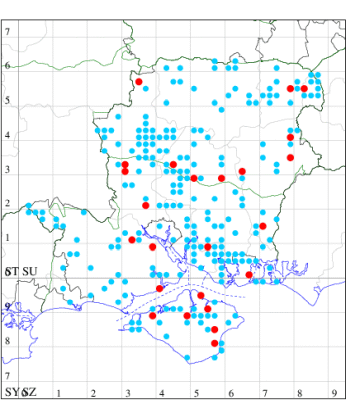
Records by year
Records by week (adult)
Records by week (larval)
Record Details
VC10: Cranmore, present, 22 Jun (CHic); Newport, one, 19 Jun; one, 20 Jun (DPl); Shanklin, one, 17 Jun (IOu); Alverstone, one, 30 Jun (DFai); Osborne Wood, one, 23 Jun (IOu); Briddlesford, one, 16 Jun (JRB);
VC11: Marchwood, one, 08 Jul (CTha); Woodlands, NF, one, 23 Jun (CJon); Romsey, one, 11 Jul (MJB); Broughton, one, 07 Jul; one, 07 Jul (GCE); Botley Wood, three, 01 Jul (KJW); Funtley, two, 10 Jun; one, 23 Jun; one, 07 Jul; one, 11 Jul; one, 16 Jul (TDC); Portsmouth, one, 22 Jun (IRT); Horndean, one, 10 Jul (PHog); Needs Ore NNR, seven, 18 Jun; 13, 03 Jul; five, 10 Jul (CNB);
VC12: Bulpits Hill, Vernham Dean, one, 10 Jul (JHal); Littleton, one, 23 Jul (GCE); Morn Hill, Winchester, one, 09 Jul (CRB, DAS, PDF et al); Cheriton, one, 12 Jul (DAS); Ropley, one, field observation, 28 Jun (TJN); Whitehill, one, 10 Jul (ASto); Blacknest, one, field observation, 20 Jun (SWom); Edenbrook CP, Fleet, one, 19 Jun (SLee); Fleet Pond, one, 06 Jul (MHals)
72.066 [B&F: 2475] Waved Black Parascotia fuliginaria (Linnaeus, 1761) - Nb
Nationally scarce (Nb) in damp woodland and log-piles in parts of southern England. In Hampshire and on the Isle of Wight was at one time virtually confined to the Bagshot Sands area of the north-east; however, the last three decades have seen it extend its range and the species is now reported in small numbers in pine-birch-heath habitats throughout. Wingspan 25-31 mm. Although the species is unmistakable once known, it is a rather atypical noctuid, more resembling a geometer superficially. Larva feeds communally on bracket fungi growing on decaying logs in damp woodland.
Records prior to 2022
| Vice County | #Records | #Individuals | First Record | Last Record |
|---|---|---|---|---|
| 10 | 1 | 0 | 1951 | 1951 |
| 11 | 640 | 667 | 1961 | 2021 |
| 12 | 421 | 441 | 1900 | 2021 |
2022 records
| Vice County | #Records | #Individuals | Max Quantity |
|---|---|---|---|
| 11 | 24 | 22 | 1 |
| 12 | 14 | 15 | 2 |
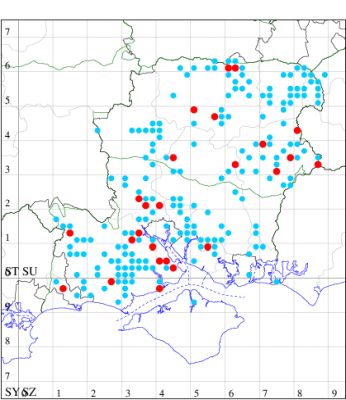
Records by year
Records by week (adult)
Records by week (larval)
Record Details
VC11: Fordingbridge, one, 22 Jul (SCT); Marchwood, one, 27 Jul (CTha); Woodlands, NF, present, 23 Jun (RBW); one, 14 Jul; one, 30 Jul (CJon); Totton, one, 16 Jul; one, 07 Aug (LHan); Fishlake Meadows, one, 26 Jul (NRJ); Fishlake, one, with Nigel Jones / Fishlake Meadows, 26 Jul (SIng); Romsey, one, 15 Jul; one, 19 Jul (MJB); Dibden Purlieu, one, 02 Jul; one, 03 Jul (RAC); Buttsash, Hythe, one, 12 Jul (JBl); Blackfied, one, to lighted window, 15 Jun (PGS); Vale Park, Chandler's Ford, one, 26 Jul (KArb); Funtley, one, 13 Jul (TDC); Hurn, one, 10 Jul; one, 14 Jul; one, 30 Jul; one, 31 Jul (MJef); Sway, NF, present, 08 Jul (DMui); Needs Ore NNR, one, 29 Jul (CNB);
VC12: Littleton, one, 23 Jul (GCE); Overton, one, 17 Jul (ACr); North Waltham, one, 18 Jul (AJon); Ropley, one, 11 Jul (KrWil); Pamber Forest, two, 11 Jul; one, 10 Jul; two, 18 Jul (GJD); Alton, one, 06 Jul; one, 13 Jul (DBO); Noar Hill HIWWT NR, Selborne, one, 08 Jul (IBla); Whitehill, one, 04 Jul (ASto); Hammer Vale, Woolmer, one, 25 Jul; one, 28 Jul (ASwa); Farnham, present, 18 Jul (iNat)
72.067 [B&F: 2470] Small Purple-barred Phytometra viridaria (Clerck, 1759) - Local
Local in calcareous grassland, heathland, moorland, woodland rides and sand-dunes throughout much of the British Isles. In Hampshire and on the Isle of Wight widespread and locally common in two different habitats, chalk downland and heaths. Wingspan 20-23 mm. Fairly unmistakable. Larva feeds on Common Milkwort and Heath Milkwort, over-wintering as a pupa.
Records prior to 2022
| Vice County | #Records | #Individuals | First Record | Last Record |
|---|---|---|---|---|
| 10 | 39 | 39 | 1951 | 2020 |
| 11 | 352 | 315 | 1951 | 2021 |
| 12 | 97 | 118 | 1951 | 2020 |
2022 records
| Vice County | #Records | #Individuals | Max Quantity |
|---|---|---|---|
| 10 | 2 | 2 | 1 |
| 11 | 9 | 12 | 5 |
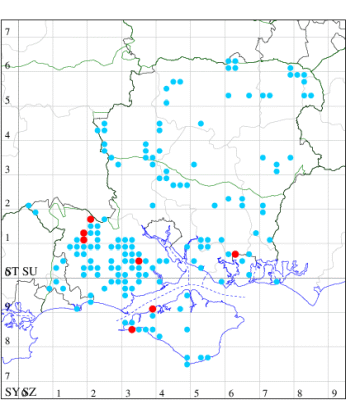
Records by year
Records by week (adult)
Records by week (larval)
Record Details
VC10: West High Down quarries, one, 12 Jul (IOu); Bouldnor, , one, field observation, 14 May (JRB);
VC11: Ogden's Purlieu, NF, two, 18 Jul; present, several, 18 Jul; present, several, 12 Jul (AMD); Hasley, NF, one, field observation, 16 Jul (JHun); present, 19 Jul; present, 19 Jul (AMD); Black Gutter Bottom, NF, five, field observation, 01 Aug; Pig Bush, NF, four, field observation, 25 Apr (NRJ); Portsmouth, present, field observation, 03 Jul (iNat)
72.069 [B&F: 2473] Beautiful Hook-tip Laspeyria flexula ([Denis & Schiffermüller], 1775) - Local
Local in woodland, parks, scrub, hedgerows, orchards and gardens throughout much of southern England and southern Wales. In Hampshire and on the Isle of Wight widely distributed in woodland. Wingspan 27-34 mm. Differences in resting posture distinguish from the unrelated but superficially similar Scalloped Hook-tip Falcaria lacertinaria. Larva feeds on lichens growing on broad-leaved and coniferous trees.
Records prior to 2022
| Vice County | #Records | #Individuals | First Record | Last Record |
|---|---|---|---|---|
| 10 | 334 | 552 | 1951 | 2021 |
| 11 | 2875 | 3650 | 1881 | 2021 |
| 12 | 1556 | 2646 | 1951 | 2021 |
2022 records
| Vice County | #Records | #Individuals | Max Quantity |
|---|---|---|---|
| 10 | 57 | 118 | 17 |
| 11 | 171 | 245 | 13 |
| 12 | 83 | 131 | 5 |
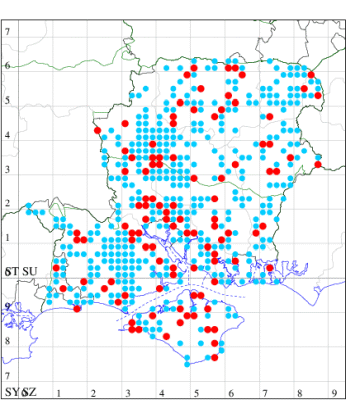
Records by year
Records by week (adult)
Records by week (larval)
Record Summary
VC10: Earliest: Bonchurch, 21 May, 1 (JHa) Latest: Shanklin, 23 Jul, 1 (IOu) Max count: Osborne Wood, 23 Jun, 17 (IOu)
VC11: Earliest: Marchwood, 28 May, 1 (CTha) Latest: Botley, 27 Oct, 1 (SLB) Max count: Needs Ore NNR, 18 Jun, 13 (CNB)
VC12: Earliest: Pamber Forest, 06 Jun, 1 (GJD) Latest: Hurstbourne Priors, 03 Oct, 1 (GCE) Max count: South Warnborough, 15 Jul, 5 (DeLee)
72.070 [B&F: 2495] Olive Crescent Trisateles emortualis ([Denis & Schiffermüller], 1775) - Nationally Scarce
A rare Red Data Book species, resident in a couple of localities in broad-leaved woodland and woodland clearings in southern England, and a priority species under the UK Biodiversity Action Plan. Historically records in Hampshire and on the Isle of Wight have been regarded as relating to immigrants from the continent but the 21st century has seen regular reports (2014 saw seven on the Isle of Wight alone) and it is probably now established as a very localised resident across the two counties. Wingspan 29-30 mm. Its light-coloured fasciae separate it from all other British Erebidae (MBGBI Vol 10). Larva feeds on Pedunculate Oak, Sessile Oak and Beech, over-wintering as a pupa.
Records prior to 2022
| Vice County | #Records | #Individuals | First Record | Last Record |
|---|---|---|---|---|
| 10 | 30 | 67 | 1900 | 2021 |
| 11 | 49 | 81 | 1999 | 2021 |
| 12 | 6 | 6 | 2011 | 2020 |
2022 records
| Vice County | #Records | #Individuals | Max Quantity |
|---|---|---|---|
| 10 | 5 | 30 | 18 |
| 11 | 12 | 14 | 2 |
| 12 | 2 | 2 | 1 |
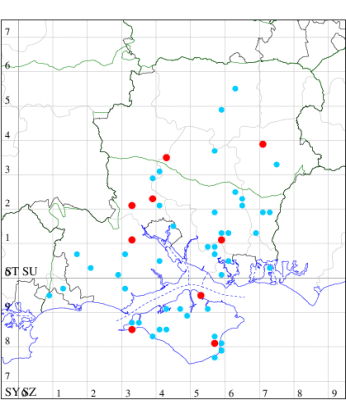
Records by year
Records by week (adult)
Records by week (larval)
Record Details
VC10: West High Down quarries, one, 12 Jul; Shanklin, one, 18 Jul; Osborne Wood, one, 30 May; nine, 23 Jun; 18, 18 Jul (IOu);
VC11: Woodlands, NF*, two, 18 Jul; one, 19 Jul (RBW); one, 14 Jul; one, 13 Jul; one, single to trap , 14 Jul; one, 23 Aug (CJon); Long Down, Shootash, one, 08 Jul (PHog); Romsey, two, 21 Jul (NRJ); Needs Ore NNR, one, 09 Jul (CNB); Wickham, one, 16 Jun; one, 11 Jul; one, 13 Jul; one, 17 Jul (JRDS);
VC12: Crawley, one, 09 Jul (GCE); Whitedown, Alton, one, 19 Jul (BCA)
72.073 [B&F: 2408] Small Marbled Eublemma parva (Hübner, [1808]) - Migrant
Immigrant from southern Europe, appearing in the south, in some years in good numbers, for example, in 1953 when a minimum of 40 were recorded, in 1968 when there were at least 30, and more recently in 2006 and 2009. In Hampshire and on the Isle of Wight benefited from small influxes in 1953 and to a lesser extent in 1968, it has become virtually annual in the 2000s, with 2011 seeing 32 records of 45 individuals across the two counties. Wingspan 16-18 mm. The most likely confusion species are Purple Marbled E. ostrina and Scarce Marbled E. minutata, which see for differences. Larva feeds on flowers of Common Fleabane and Ploughman's-spikenard, unable to over-winter in significant numbers.
Records prior to 2022
| Vice County | #Records | #Individuals | First Record | Last Record |
|---|---|---|---|---|
| 10 | 26 | 39 | 1880 | 2019 |
| 11 | 52 | 56 | 1968 | 2021 |
| 12 | 10 | 24 | 1953 | 2015 |
2022 records
| Vice County | #Records | #Individuals | Max Quantity |
|---|---|---|---|
| 10 | 1 | 1 | 1 |
| 11 | 1 | 1 | 1 |
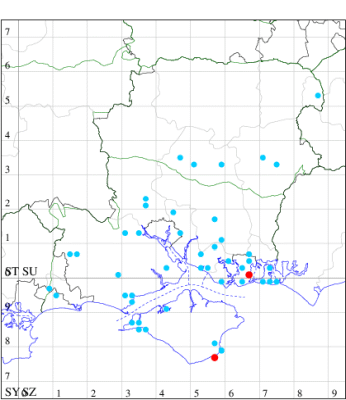
Records by year
Records by week (adult)
Records by week (larval)
Record Details
VC10: Bonchurch, one, 02 Aug (JHa);
VC11: Brockwood, two, 26 Aug (SDut); Portsmouth, one, 12 Jul (IRT)
72.074 [B&F: 2409a] Beautiful Marbled Eublemma purpurina ([Denis & Schiffermüller], 1775) - Migrant
An increasingly common migrant from southern Europe, appearing in southern England for the first time in Dorset in 2001, but only identified from a set specimen during 2004, a year which saw an influx of some eight moths of this previously unrecorded species. In Hampshire the first was trapped at Cheriton Wood, vice-county 12, on 31 July 2004, and the second at Southsea, vice-county 11, on 16 August 2004 - these were the second and third British records. Subsequently recorded at Waterlooville on 6 August 2005 and at Beaulieu on 30 July 2006, both in vice-county 11. The Isle of Wight had to wait until 2018 for its first record, and since that year it has been recorded annually, sometimes multiple times, in both counties. Wingspan 26-30 mm. Some poorly marked specimens resemble f. carthami of Purple Marbled E. ostrina, however the postmedian fascia which bisects the purple distal half of the wing in Beautiful Marbled is absent in Purple Marbled. Larva feeds on Creeping Thistle, no evidence of breeding in the UK.
Records prior to 2022
| Vice County | #Records | #Individuals | First Record | Last Record |
|---|---|---|---|---|
| 10 | 11 | 11 | 2018 | 2021 |
| 11 | 9 | 9 | 2004 | 2020 |
| 12 | 8 | 9 | 2004 | 2021 |
2022 records
| Vice County | #Records | #Individuals | Max Quantity |
|---|---|---|---|
| 10 | 1 | 1 | 1 |
| 11 | 1 | 1 | 1 |
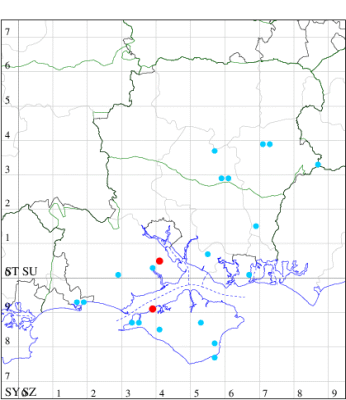
Records by year
Records by week (adult)
Records by week (larval)
Record Details
VC10: Bouldnor*, one, field observation, 12 Jul (JRB);
VC11: Dibden Purlieu*, one, 30 Aug (RAC)
